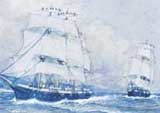
reproductionThe corvette Trajano, 1,414 tons from 1873: greater stability, speed and cargo capacityreproduction
An innovative format for the immersed part of ships hulls, known as careen, obtained excellent results in 1868, when it was invented by the naval engineer from the State of Santa Catarina, Trajano Augusto de Carvalho. It should be no surprise. Its creation allowed the ship to more easily overcome the resistance of the water and increased its speed at the same time that it reduced the fuel consumption. It also improved the stability and the control of the ship, allowing for a greater cargo capacity and reducing the construction costs. This spectacular performance was proven in real experiments with ships built with these characteristics in Brazil and especially in England.
The retired professor of the Polytechnic School of the Federal University of Rio de Janeiro, a student of the theme, Pedro Carlos da Silva Telles, says that the invention was, most probably, the first technological research to have repercussions in the exterior, where it was also patented. The Innovation of Trajano’s Careen, as the invention was called at that time, basically modified the bow of the ships. He exchanged the open midship frame in “V”, as was usual, for the format in a “U”, with the broadsides practically vertical.
In this form, the water lines gained a format of a wedge, which lowered the resistance to the advance of the ship. However, all of the recognition for the innovation fell into a complete state of forgetfulness. The only pictures of the Trajano system that are known of are in the Naval Museum of Rio de Janeiro. They are water colors painted by his son – who had the same name, Admiral Augusto Trajano de Carvalho – and three scale-models that represent the four ships constructed by the Court’s Naval Arsenal with the new design. The first of them, a corvette, received the name Trajano by the suggestion of the Emperor Don Pedro II himself, in homage of the inventor.
Republish